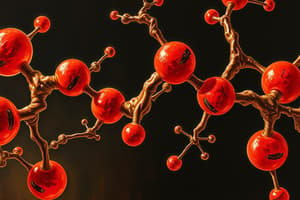Podcast
Questions and Answers
What is the function of hemoglobin in red blood cells?
What is the function of hemoglobin in red blood cells?
- To fight infection
- To carry oxygen from the lungs to the body's tissues (correct)
- To regulate blood pressure
- To produce energy for the cell
What is the structure of hemoglobin?
What is the structure of hemoglobin?
- A monomer consisting of one subunit
- A dimer consisting of two subunits
- A trimer consisting of three subunits
- A tetramer consisting of four subunits (correct)
What is the effect of oxygen binding on hemoglobin?
What is the effect of oxygen binding on hemoglobin?
- It has no effect on affinity for oxygen
- It leads to the release of oxygen
- It causes a conformational change that increases affinity for oxygen (correct)
- It causes a decrease in affinity for oxygen
What is the type of hemoglobin found in fetuses and newborns?
What is the type of hemoglobin found in fetuses and newborns?
What is an additional function of hemoglobin beyond oxygen transport?
What is an additional function of hemoglobin beyond oxygen transport?
What is the significance of abnormal hemoglobin variants?
What is the significance of abnormal hemoglobin variants?
Flashcards are hidden until you start studying
Study Notes
Structure and Function
- Hemoglobin (Hb) is a protein in red blood cells that carries oxygen from the lungs to the body's tissues.
- It is a tetramer, consisting of four subunits: two alpha globin and two beta globin chains.
- Each subunit has a heme group, which contains an iron atom that binds to oxygen.
Oxygen Binding
- Hemoglobin binds to oxygen in the lungs, forming oxyhemoglobin (HbO2).
- Oxygen binding causes a conformational change in the hemoglobin molecule, which increases its affinity for oxygen.
- The binding of oxygen is cooperative, meaning that the binding of one oxygen molecule increases the affinity for additional oxygen molecules.
Types of Hemoglobin
- Hemoglobin A (HbA) is the most common type, found in adults.
- Hemoglobin F (HbF) is found in fetuses and newborns, and has a higher affinity for oxygen.
- Hemoglobin S (HbS) is a variant that causes sickle cell disease.
Functions Beyond Oxygen Transport
- Hemoglobin also plays a role in buffering excess hydrogen ions in the blood, helping to maintain acid-base balance.
- It has antioxidant properties, helping to protect the body from oxidative stress.
Clinical Significance
- Hemoglobin levels are used to diagnose and monitor anemia, polycythemia, and other blood disorders.
- Abnormal hemoglobin variants can cause disease, such as sickle cell disease and thalassemia.
Structure and Function
- Hemoglobin (Hb) is a protein in red blood cells that carries oxygen from lungs to body tissues.
- Hb is a tetramer, consisting of four subunits: two alpha globin and two beta globin chains.
Oxygen Binding
- Hemoglobin binds to oxygen in lungs, forming oxyhemoglobin (HbO2).
- Oxygen binding causes a conformational change in Hb, increasing its affinity for oxygen.
- The binding of oxygen is cooperative, increasing affinity for additional oxygen molecules.
Types of Hemoglobin
- Hemoglobin A (HbA) is the most common type, found in adults.
- Hemoglobin F (HbF) is found in fetuses and newborns, with a higher affinity for oxygen.
- Hemoglobin S (HbS) is a variant that causes sickle cell disease.
Functions Beyond Oxygen Transport
- Hemoglobin helps maintain acid-base balance by buffering excess hydrogen ions in blood.
- It has antioxidant properties, protecting the body from oxidative stress.
Clinical Significance
- Hemoglobin levels diagnose and monitor anemia, polycythemia, and other blood disorders.
- Abnormal hemoglobin variants cause disease, such as sickle cell disease and thalassemia.
Studying That Suits You
Use AI to generate personalized quizzes and flashcards to suit your learning preferences.



